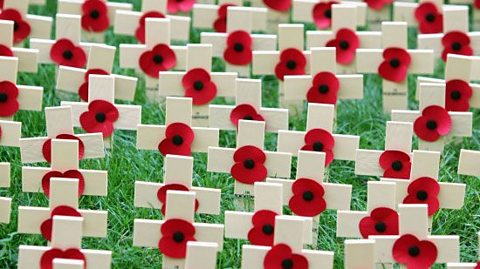What is 'London' about?
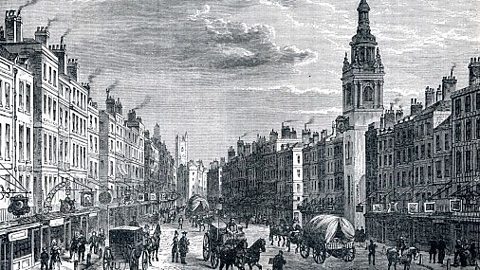
London by William Blake was published in 1794.
It tells the story of a speaker walking through the city of London and noticing suffering all around them.
London was published in Blake's poetry collection called Songs of Innocence and Experience.
Songs of Experience explores how the world, power and life in general can corruptActing dishonestly for personal gain. people.
Songs of Innocence focuses mostly on the naivety of childhood.

What happens in 'London'?
The Poem
In the poem, the speaker walks through London and observes the suffering going on around them. For example, they hear the cries of men, babies and chimney sweeps; they see the dirty walls of the church; observe a soldier sighing, a young woman cursing and a sense of death all around them.
Blake wrote the poem to illustrate how London, the city he loved, was changing beyond recognition due to its industrialisation.
He also wanted to show how many people living in the city were being forgotten by those with wealth and power.
Much of BlakeÔÇÖs poetry sought to highlight the difference between social classes and improve the welfare of others.

Context
William Blake was a Romantic poet. This means that he wrote during the Romantic eraA literary era of poetry (from the late 18th and early 19th Century) which focused more on feeling and nature. in the late 18th and early 19th century.
The rapid industrialisationChanges in the way products are made. Production is based in factories and more of the work is done by machines. of towns and cities inspired many artists and poets to seek an escape into nature. They focused on topics like nature, creativity and individuality, whilst still hinting at the hardships of reality.
Concerns about rapid industrialisation are reflected in London. The poem criticises the greed and imbalance of the power that the Industrial Revolution created between wealthy factory owners and their workers.
The Romantics wanted people to prioritise creativity and individuality and these values were in direct contrast to those of the Industrial Revolution.

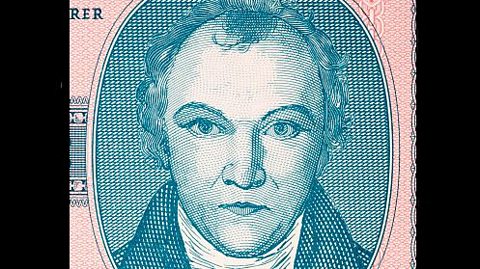
Question
What did Blake want to raise awareness of through the poem?
Answer
Blake wanted to point out the ways that London was changing. He also aimed to highlight the suffering that many people living in London were facing as a result of the greed of those in powerful positions.
Themes
Power
London draws attention to the contrast between those with power and those without power at the end of the 18th century. The everyday people that the speaker meets on his walk are all powerless, including himself: ÔÇťevery faceÔÇŁ shows sadness.
Blake draws attention to the power imbalance when he uses the juxtaposeTo place two contrasting things closely together.:
And the hapless Soldiers sigh
Runs in blood down Palace walls.
Blake paints an image of an unlucky (ÔÇťhaplessÔÇŁ), helpless soldier who has to give his life, his ÔÇťbloodÔÇŁ, in service to those in power. In contrast, the ÔÇťPalace wallsÔÇŁ protect the powerful, including the royal family, from danger or death.
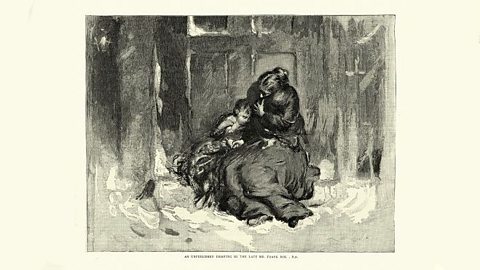
Wealth
When Blake refers to the streets and rivers of London as being ÔÇťcharterÔÇÖedÔÇŁ, he is commenting on how they are all owned by rich landowners. ÔÇťCharterÔÇÖedÔÇŁ can also mean they are written on maps, or that they are someoneÔÇÖs property.
ÔÇ└ß wander throÔÇÖ each char│┘▒░¨ÔÇÖd street,
Near where the char│┘▒░¨ÔÇÖd Thames does flow.ÔÇŁ
There is the sense, enhanced by repetition, that London belongs to the rich ÔÇô despite the fact that so many other people live there too.
ÔÇťCharterÔÇÖedÔÇŁ can also suggest a sense of restriction and lack of freedom. Something that should flow freely, like the Thames river, is being controlled by a minority of privileged people.
Appearance and reality
Blake juxtaposes the appearance of London ÔÇô its impression of grandeur and wealth ÔÇô with the reality of life for the majority of its inhabitants.
| Appearance | Reality |
|---|---|
| ÔÇťChar│┘▒░¨ÔÇÖd streetÔÇŁ and ÔÇťchar│┘▒░¨ÔÇÖd ThamesÔÇŁ suggests order and civilisation. | ÔÇťMarks of weakness, marks of woeÔÇŁ highlight the widespread suffering of those living in the city. |
| ÔÇťPalace wallsÔÇŁ sound impressive and creates imagery of royalty and wealth. | ÔÇťRuns in bloodÔÇŁ reminds the reader of the pain and sacrifices being made by the everyday people. |
| ÔÇťChurchÔÇŁ and ÔÇťmarriageÔÇŁ are words which could have positive connotations of love and faith. Their presence suggests peace and prosperity in the community. | The church is ÔÇťblackningÔÇŁ and ÔÇťappalsÔÇŁ the viewer. This implies its corruption. The marriage is ÔÇťblighted with plagueÔÇŁ implying that an institution designed to encourage health and prosperity is responsible for disease. |
Mini quiz
Language
In poetry, language is anything to do with words and the way in which they are used.
Metaphor
A metaphor symbolises or represents something else without using the words 'like' or 'as'.
One important metaphor that Blake uses is ÔÇťmind-forg'd manaclesÔÇŁ. ÔÇťmanaclesEither refers to chains or a part of someone being confined or trapped.ÔÇŁ are like handcuffs and ÔÇťmind-forged(written as ÔÇťforgÔÇÖdÔÇŁ in the poem): Made falsely.ÔÇŁ means that they have been imagined.
Blake is suggesting that, due to industrialisation and poverty, the people of London are trapped by their own lack of freedom and imagination. They feel constrained and are unable to even imagine happiness because of the current situation they live in.
First Person
London is written in first-personWhen a narrator tells the story from their own point of view., which means Blake uses the pronoun ÔÇ└ßÔÇŁ. This creates a realistic and personal feel to the poem ÔÇô as though Blake himself is walking through London and commenting first-hand on what he sees. This gives the poem more authority and urgency as his descriptions feel ÔÇśrealÔÇÖ.
Emotive Language
Emotive language refers to language that explores or evokes emotion.
Blake uses emotive language throughout this poem to highlight the widespread issues in London at the time. Some examples are:
| Example | Interpretation |
|---|---|
| ÔÇťMarks of weakness, marks of woeÔÇŁ | The alliteration of ÔÇťweaknessÔÇŁ and ÔÇťwoeÔÇŁ (which means sadness) draws attention to the negative feelings reflected all around. |
| ÔÇ└ßn every cryÔÇŁ | ÔÇťCryÔÇŁ is an emotive word suggesting unhappiness or pain. It is repeated three times in the poem, emphasising how prevalent the suffering is. |
| ÔÇťYouthful HarlotÔÇŁ and ÔÇťnew-born InfantÔÇŁ | Drawing attention to the young age of the people suffering encourages the reader to feel more sympathyFeeling pity for someone elseÔÇÖs suffering. towards them. |
| ÔÇ┬┘ż▒▓Á│ˇÔÇŁ | Along with other words that evoke sound (like ÔÇťcryÔÇŁ and ÔÇťcurseÔÇŁ), Blake uses the sense of sound for emotive effect. It suggests that the suffering isnÔÇÖt just there to be seen, but to be heard also. It is all-encompassing. |
Structure
In poetry, structure is anything to do with layout and organisation.
Repetition
Blake uses repetition to emphasise the pain and loss of power throughout London. He repeats the word ÔÇťeveryÔÇŁ, highlighting how almost everyone is affected by the changes happening in the city.
As with the other structural choices he makes, repetition gives the poem a dull and automatic feeling. It also stresses that that poverty and pain is everywhere in London and should not be ignored.

Question
What could you say about the language and structure in these lines?
ÔÇ└ßn every cry of every Man,
In every Infants cry of fear,
In every voice in every banÔÇŁ
Answers
The repetition of ÔÇťeveryÔÇŁ is used to highlight how the issues in London affect so many people.
Emotive language is used when Blake references the ÔÇ└ßnfantsÔÇŁ drawing attention to how even the youngest and most innocent are suffering too.
Blake also repeats the sound of crying to illustrate how sounds of pain can be heard across the city, not just seen.
The iambic tetrameter adds a feeling of repetitiveness and dullness.
The ABAB rhyme scheme adds a sense of predictability and monotony.
Form
In poetry, form refers to the type of poem that the poet choose to write.
Quatrains
A quatrain is a stanzaA set of lines grouped together in a poem. made up of four lines.
London is written as four quatrains which gives it a predictable, repetitive feel.
One reason for this is to reflect the monotonyRepetitive and lacking variety and interest. and uniform nature of machines, which were taking over lots of jobs due to the industrial revolutionThe process that transformed manufacturing from handmade to machine-made, mass produced goods using water, steam and coal power transported by canal, rail and steamship. Britain was the first country to have an industrial revolution., causing high levels of unemployment and poverty.
Blake also uses this repetitive structure to mirror the helplessness that he and the everyday people feel - the monotonous nature of poverty and the idea that nothing will ever change for the better.
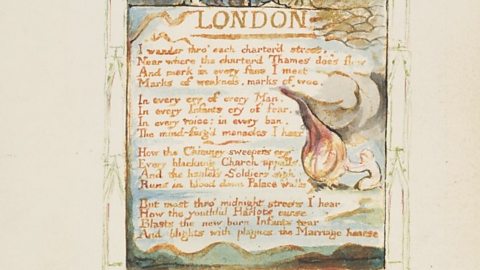
ABAB rhyme scheme
An ABAB rhyme scheme means that alternating lines rhyme with each another. For example, in the last stanza:
ÔÇťBut most thro' midnight streets I hear (A)
How the youthful Harlots curse (B)
Blasts the new-born Infants tearÔÇ»(A)
And blights with plagues the Marriage hearse (B)ÔÇŁ
As with the quatrains, the rhyme scheme gives a robotic or monotonous effect.
When paired with the negative language throughout the poem, this monotonous inevitability links to the powerlessness that Blake feels about what is happening to the city he lives in.
Blake may also have wanted to create a nursery-rhyme or childlike feel to the poem to mockTo make fun of. the idea that London was a utopiaAn imagined place where everything is perfect., as those in power often presented it to be. The nursery rhyme style also suited the theme of childhood from the collection the poem was a part of.
Iambic tetrameter
Iambic tetrameter refers toÔÇ»a line that contains four sets of two beats. In each pair, the first beat (or syllable) is unstressed, and the second beat (or syllable) is stressed.ÔÇ»For example: ÔÇťde dum de dum de dum de dum.ÔÇŁ
London is written in iambic tetrameter. The words in bold are the stressed beats:
ÔÇ└ß wander throÔÇÖ each char│┘▒░¨ÔÇÖd street,
Near wherethe char│┘▒░¨ÔÇÖd Thames doesflow*"
As with the quatrains and regular rhyme scheme, Blake wanted to reflect the monotony of machinery being used during the Industrial Revolution and also his feelings that nothing will change for the better. The iambic tetrameter creates a repetitive, plodding feel.
Top Tips (Edexcel)

Remember
Read the question carefully. Highlight the key words and focus of the question.
Make a plan. Annotate the poem or create a short list of points you could make, supported by evidence. This will help you to stay focused and relevant.
Analyse features. When you identify a feature, always consider why it has been used and what effect it creates.
Reread your answer. Keep checking that you are on topic throughout the writing process.
╠ř
╠ř

Making comparisons
You will need to write your response using comparative connectives, such as:
Similarly
Likewise
However
In contrast

In the exam
This poem could be assessed in the anthology poetry part of the exam.
You will be asked to compare a named poem with a poem of your choice. The choice must be from the cluster of poems you have studied.
The named poem will be provided.
This question assesses AO2 and AO3:
| AO2 | AO2 assesses your ability to explore the language, form and structure used by a writer to create meanings and effects. |
| AO3 | AO3 looks at how you can link the contextual background of the poem(s) into your ideas. |
Quiz
Test your understanding of the poem London by taking this quiz.
More on Poems
Find out more by working through a topic
- count1 of 4
